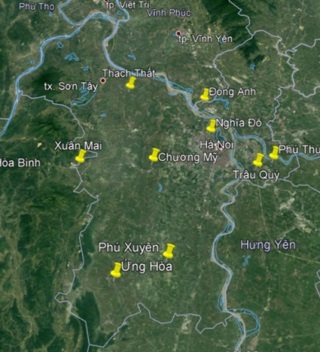 |
|
A member of staff at the meteorological and hydrological station in Cua Lo Town, central Nghe An Province measures sunshine hours during a day.
|
Government have paid close attention to detailed extreme weather condition forecasting and early warning of natural disasters following the 12th Party Congress document in improving climate change monitoring capacity.
Facing more severe weather conditions like floods in the central region last October, the weather forecasting agencies have applied new technology to help predict and issue early warnings of typhoons five days before they make landfall and warning of tropical depression three days earlier.
Rainfall warnings and severe cold waves now happen two to three days earlier with the accuracy rate of about 75 to 90 per cent.
Professor Tran Hong Thai, head of the Vietnam Meteorological and Hydrological Administration, said in 2019 and 2020, the industry forecasted accurately weather trends, especially water shortages and saltwater intrusion in the central and southern regions, thereby reducing damage in the agricultural sector by 9.6 per cent compared to 2016.
The sector promptly warned and forecasted the development of 13 typhoons and one tropical depression, 21 cold waves, 13 heat waves, 18 large-scale heavy rains and 17 floods nationwide. Thanks to the prediction, local people took preventive measures to minimise damage.
The sector has also modernised the network of hydro-meteorological monitoring stations with State and private investment in 782 independent rain-measuring stations and 284 surface meteorological stations. Hundreds of environmental monitoring stations have been built, connecting directly with the Ministry of Natural Resources and Environment and provincial/city environmental departments.
The Vietnam Meteorological and Hydrological Administration has put into operation 63 satellite positioning stations, providing precise positioning services for socio-economic activities.
In the context of climate change and intense weather conditions, the Vietnamese weather forecasting agencies have improved predicting capacity, especially early, detailed warning of natural disasters.
Professor Tran Hong Thai said the Vietnam Meteorological and Hydrological Administration said they would enhance the forecasting capacity towards a modern direction, on par with the World Meteorological Organisation. The weather forecast will show detailed prediction of each city and town. In particular, the sector will synchronise and modernise hydro-meteorological forecasting and warning technology, improving service quality.
The administration will modernise the monitoring networks in the northern region, mountainous areas where rain and storms often occur with high intensity. About 150 automatic hydro-meteorological control stations along the sea and islands will be invested, he said. VNS

Developing human resources for meteorology industry
Professor Tran Hong Thai, general director of Vietnam’s General Department of Meteorology, talks about the improvements of Vietnam's meteorology industry

Hanoi sets up weather warning system
The Institute of Geophysics at the Ministry of Science and Technology has successfully built a modern warning and monitoring system to collect input data for forecasting heavy rain and flooding in Hanoi.